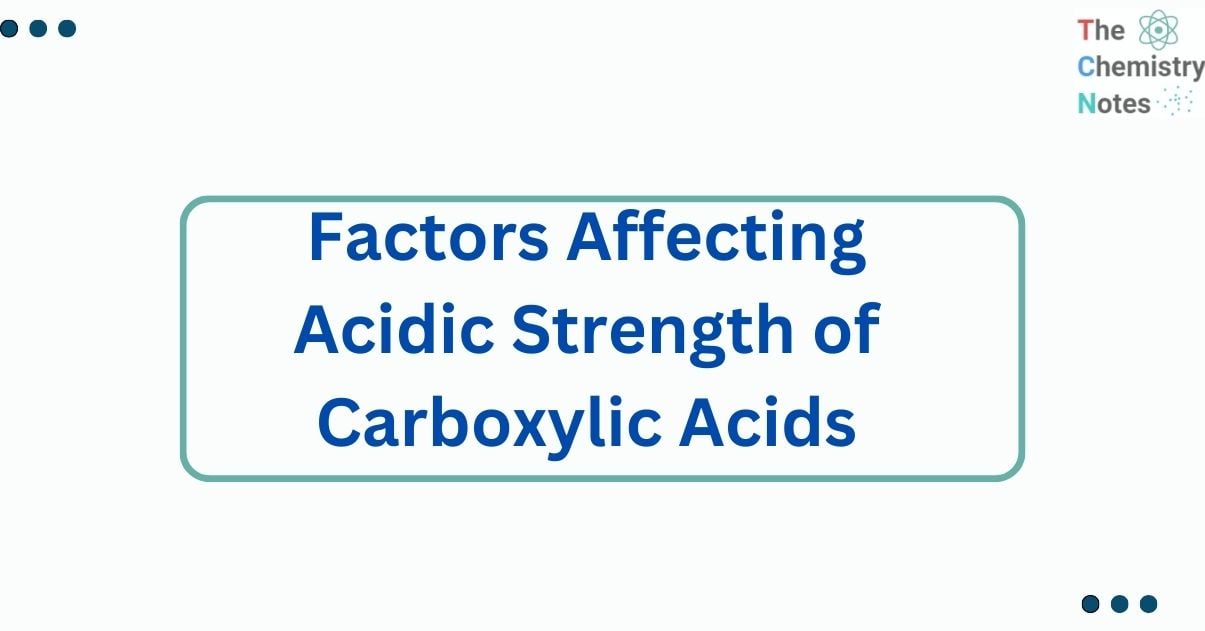
Several factors influence the acidic strength of carboxylic acids. These factors are classified as structural and environmental.
Factors Affecting Acidic Strength of Carboxylic Acids
The acidic strength of carboxylic acids can be affected by the solvent used. Carboxylic acids tend to break down more easily into carboxylate ions and protons in polar solvents, increasing their apparent acidity.
Temperature
Increased temperatures often favor carboxylic acid dissociation, resulting in increased acidity.
Molecular size and structure
Bulkier carboxylic acids may have lower acidity due to steric hindrance, which prevents protons from dissociating effectively.
Hybridization of carbon attached next to the carboxylic group
Carboxylic acids with a sp-hybridized carbon atom (for example, ethynoic acid – HCCOOH) are more acidic than those with sp2- or sp3-hybridized carbon atoms. This is because the increased s-character in sp-hybridized carbon results in increased acidity.
Effect of substituent
When certain substituents are put into a carboxylic molecule at specific locations, the acidic strength varies.
Nature of substituent
The acidic strength increases when the Withdrawing group is introduced, whereas the opposite effect is observed when the Donating group is introduced.
When an electron-withdrawing group is connected, the carboxylate ion is more stable because the negative charge is dispersed. It will contribute to the release of more protons. In the case of an electron-donating group, the carboxylate group will have a higher concentration of negative charge, reducing the carboxylate ion’s stability. As a result, proton liberation will be inhibited by aliphatic acids. The following observations are made in this section.
- It has been discovered that hallo acetic acid is more potent than acetic acid. Furthermore, the acid intensity varies with halogen. Because fluorine is more electronegative than chlorine chlorine is more electronegative than bromine, fluoroacetic acid is more acidic than bromoacetic acid.
FCH2COOH > ClCH2COOH > BrCH2COOH > ICH2COOH
Number of substituents
The number of such electron-withdrawing groups in an acid determines its acid strength. The larger the number of electron-withdrawing groups, the stronger the acid. As a result, dichloroacetic acid is more potent than monochloroacetic acid, and trichloroacetic acid is stronger than dichloroacetic acid.
Cl3CCOOH > Cl2CHCOOH > ClCH2COOH
The acid strength is reduced when an electron-repelling group is substituted in the carboxylic acid. The greater the number of such elements, the stronger the effect.
It should be noted that a propyl group has a stronger electron-repelling impact than an ethyl group, which has a greater repelling effect than a methyl group. Thus, the following are the strengths of the first four homologous series of carboxylic compounds:
Acetic acid > Propionic acid > Butyric acid > Formic acid
Position of substituents
The acid’s strength is determined by the position of the electron-withdrawing group in relation to the carboxyl group. The acid strength increases as the electron-withdrawing group gets closer to the carboxyl group. As a result, (α -chloropropionic acid is more potent than ß- chloropropionic acid.
Aromatic carboxylic acid
- Electron-donating substituents reduce the acidity of substituted benzoic acids, whereas electron-withdrawing substituents enhance the acidity. The acidity, on the other hand, changes with the position of the substituents. When electron releasing/drawing substituents are in the para position, the decrease or rise in acid strength is more pronounced. Substituents in the meta position have a milder effect on acidity. Regardless of the type of substituents, all ortho-substituted benzoic acids are stronger than benzoic acids. This is known as the Ortho Effect, and it is most likely the result of a combination of steric and electrical causes.
- The o— and p-nitrobenzoic acids are stronger than the meta-nitrobenzoic acid acid. However, m-nitro-benzoic acid is stronger than benzoic acid as a group that attracts the electron, however weakly, by inductive effect at the meta location.
- p-chlorobenzoic acid is a stronger acid than benzoic acid but weaker than m-chlorobenzoic acid because the inductive impact of Cl is larger when it is in the meta position than when it is in the para position (the inductive effect diminishes with distance). The acid p-nitrobenzoic acid is stronger than the acid p-chlorobenzoic acid. This is due to the positively charged nitrogen of the nitro group in p-nitro benzoic acid, which has a greater electron-withdrawing effect. In addition, non-bonding electrons of -Cl enhance the electron density (acid weakening) of the ring in p-chlorobenzoic acid.
- Substituted benzoic acids with hydroxy and alkoxy substituents in the meta and ortho positions exhibit unusual behavior. They are more potent acids than benzoic acid. Both -OCH3 and -OH exhibit resonance and inductive properties. Because the inductive effect (electron-withdrawing effect) overcomes the para-position resonance effect (electron-releasing effect), para-hydroxy and para-methoxy benzoic acids are weaker than benzoic acid. Because the inductive effect operates at the meta position, meta-hydroxy and meta-methoxy benzoic acids are stronger benzoic acids.
- Despite expectations, ortho hydroxyl benzoic acid is a stronger acid than benzoic acid. As a general rule, a group is in the opposite direction. is a stronger acid than benzoic acid. A group in the ortho position always increases the acid strength, as a general rule. This is known as the ortho effect. Thus, o-compound will be the strongest acid among O—, m—, and p-substituted benzoic acids. However. This effect has no satisfactory explanation.
References
- Morrison, R. T., & Boyd, R. N. (1983). Organic chemistry. Boston: Allyn and Bacon.
- Sthapit, M. K., Pradhananga, R. R., Bajracharya, K. B., (2014). Foundations of chemistry. Taleju Prakashan.
- Arun Bahl, B.S. Bahl and G.D. Tuli. (1999). Study Guide and Solutions Manual For : Essentials of Physical Chemistry (1). New delhi: S. CHAND.
- https://byjus.com/chemistry/alkene/
- https://www.scribd.com/document/662944845/factors-affecting-acidic-strength-of-carboxylic-acids
- https://www.masterorganicchemistry.com/2010/09/22/five-key-factors-that-influence-acidity/
- https://chem.libretexts.org/Bookshelves/Organic_Chemistry/Map%3A_Organic_Chemistry_(Wade)Complete_and_Semesters_I_and_II/Map%3A_Organic_Chemistry(Wade)/21%3A_Carboxylic_Acids/21.02%3A_Acidity_of_Carboxylic_Acids
